Critical Environmental Factors in Offshore Wind–Hydrogen Projects: Uruguay’s Exclusive Economic Zone
Abstract
1. Introduction
- Physical Component: Includes seabed and soil characteristics, ambient noise levels, surface water quality, air quality, surface water temperature and hydrochemistry, and pressures on natural resources.
- Biotic Component: Covers fauna (e.g., plankton, benthos, nekton, fish, birds, reptiles, marine mammals, and cephalopods) and flora (e.g., aquatic vegetation and coastal plant communities).
- Anthropic Component: Encompasses human-related aspects such as landscape, fishing activities, maritime navigation, and terrestrial and marine traffic.
2. Methodology
Identification of the Exclusive Economic Zone of Uruguay
- Restingas del Pez Limón: An essential habitat for benthic species of ecological interest.
- Pozo de Fango: A highly productive area where commercial species such as hake are concentrated.
- Breeding Zones: Critical for the conservation of juvenile fish and cephalopods.
3. Results
3.1. Development Phase
- Disturbance to marine fauna due to geophysical and geotechnical studies: The results indicate that the methods used for seabed characterization (e.g., airgun seismic surveys and high-resolution geophysical studies) [21,22] generate low-frequency, high-intensity sound waves that can cause stress or injuries in marine mammals and fish [23]. Notable impacts include potential physical damage (barotrauma and swim bladder impairment) and behavioral changes (e.g., avoidance of survey areas) in bony fish species, as well as disturbances to cetaceans and marine turtles [24].
- Localized alteration of the seabed and benthic habitats: The installation of measurement buoys and wind towers during the early phases may involve minor drilling and anchoring, which can displace sediments and affect benthic species (e.g., polychaetes and crustaceans) [25]. Although these localized disturbances are not typically extensive, they become significant if they occur in ecologically sensitive areas or breeding grounds for commercial species (e.g., hake and croaker).
- Increased maritime traffic and associated risks: The need for inspection vessels and technical personnel increases maritime traffic in the study area, raising the risk of collisions with marine mammals and turtles, as well as accidental fuel spills [26]. Additionally, this increased traffic may temporarily interfere with coastal and offshore fishing activities, potentially generating socioeconomic tensions.
3.2. Construction Phase
- Intense underwater noise generation: The use of hydraulic hammers for driving monopiles or anchoring foundations for offshore wind turbines and platforms generates very high acoustic peaks, affecting marine mammals, fish, and cephalopods within a radius that can reach tens of kilometers [11] in the EEZ. This noise is exacerbated in areas with hard seabeds, where higher impact force is required, and is further compounded by noise from dredging and intensive ship traffic [23].
- Water quality alteration and sediment suspension: Dredging for the installation of submarine cables and excavation of foundations disturbs fine sediments and contaminants deposited on the seabed, increasing turbidity and potentially releasing heavy metals [25]. In high-productivity environments, turbidity alteration has been observed to impact photosynthesis and primary productivity, thereby affecting trophic networks (plankton–nekton).
- Port congestion and waste generation: The transport of large components (foundations and wind turbines) and equipment for electrolysis plants exerts significant pressure on ports, requiring large-scale storage and logistics spaces [11]. Construction generates volumes of solid waste (packaging materials, welding remnants, etc.) and liquid waste (oils and lubricants), which, in the absence of proper management protocols, could leak into the marine environment.
3.3. Operation Phase
- Collision risks with wind turbines and infrastructure: Seabirds, particularly migratory species, are at risk of colliding with wind turbine blades under conditions of low visibility or strong winds [27]. Marine mammals and reptiles face collision risks with maintenance vessels, which typically operate throughout the entire lifespan of the wind farm [26].
- Acoustic disturbances and continuous vibrations: Although the operational noise of wind turbines is lower than during construction, low-frequency underwater emissions persist, potentially affecting the communication and behavior of marine mammals [24]. Additionally, electrolysis, compression, and hydrogen storage systems generate additional mechanical noise, which propagates through the structures of the platforms.
- Brine generation and management: If the electrolysis process is implemented offshore, seawater desalination is required, producing brine with high ionic concentrations that can increase local salinity when discharged [28]. International studies suggest that implementing diffusers and staggered discharge plans can mitigate the impact. However, in areas with limited circulation, this brine could harm benthic biota and reduce oxygen availability.
- Creation of artificial reefs: Submerged structures—such as fixed and floating foundations, as well as anti-erosion coverings—provide hard surfaces for invertebrate colonization, potentially aiding the regeneration of certain communities [24]. In areas with restricted fishing, fish tend to aggregate around these new habitats, increasing local biodiversity and creating refuge zones [25]. This impact is not always beneficial as it could also lead to an increase in invasive species populations that may alter the ecosystem.
4. Discussion of Results
4.1. Vulnerability of the Biotic Environment and Impact Synergies
4.2. Alterations to the Physical Environment and Ecosystem Consequences
- The implementation of brine diffuser systems designed through site-specific hydrodynamic modeling can promote rapid dilution and dispersion of high-salinity effluents, minimizing localized impacts and protecting benthic habitats [28]. In the context of Uruguayan regulation, where effluent dilution is restricted, controlled return of brine through a regulated outfall system may be a viable alternative.
- Installing robust wastewater treatment systems aboard vessels and onshore facilities is essential for removing pollutants before discharge.
- Strict chemical management protocols must be enforced for the safe storage, handling, and disposal of maintenance-related substances used in electrolyzers and offshore turbines.
- Brine mining technologies can be explored to recover valuable salts and reduce the environmental load of salinity waste [35].
- Continuous environmental monitoring programs should be established to assess real-time changes in water quality parameters and guide adaptive management actions. Baseline ecological surveys are also key to understanding site-specific sensitivities and tailoring mitigation accordingly.
4.3. Interactions with the Anthropic Environment
- Fisheries Coexistence Planning: Engage the fishing sector in early planning to minimize conflicts and ensure continued access where possible. Consider turbine spacing (800–1000 m) to allow passive fishing activities and vessel navigation [25].
- Navigation Restrictions: Implement regulated navigation and fishing exclusion zones during construction and operation phases to protect both marine fauna and project infrastructure.
- Ban on Bottom Trawling: Restrict bottom trawling in wind farm areas to reduce habitat disturbance and sediment resuspension while protecting subsea cables.
- Safety Protocols for Hydrogen: Adopt national codes and standards tailored to hydrogen technologies and assess safe distances from storage and production units using quantitative risk assessment [36].
- Stakeholder Engagement: Foster transparent dialogue and participatory processes with local fishers and maritime users throughout project design and implementation.
4.4. Potential Positive Effects: Artificial Reefs and Economic Diversification
4.5. Cumulative Impacts and the Need for Coordination
4.6. Recommendations and Future Vision
- Development of a Comprehensive Regulatory Framework
- Marine Spatial Planning (MSP)
- Promotion of Research and Baseline Studies
- Environmental Impact Assessment (EIA)
- Infrastructure and Logistics Development
- Capacity Building and Skills Development
5. Conclusions
Author Contributions
Funding
Institutional Review Board Statement
Informed Consent Statement
Data Availability Statement
Conflicts of Interest
Appendix A
| Activity | Environmental Impact | Component | Environmental Factor | Outreach |
|---|---|---|---|---|
| Geotechnical and geophysical studies | Disturbance to marine fauna | Biotic | Marine fauna | Due to disturbances during sampling times. |
| Disturbance of the seabed | Biotic | Marine fauna and flora | Possible removal of the seabed in study areas [42]. | |
| Increased noise levels | Physical | Sound Pressure Levels | Noise from surveys may injure marine species [30]. | |
| Increased maritime traffic | Anthropic | Navigation | Due to presence of vessels in the study area. | |
| Effect on air quality | Physical | Air quality | Emissions from study vessels. | |
| Impact on water quality | Physical | Water quality | Spills or sediment movements increasing turbidity. | |
| Alteration of marine habitats | Biotic | Marine fauna | Disturbance due to noise, sediment, or contamination [30]. | |
| Environmental studies | Increased noise levels | Physical | Sound Pressure Levels | Noise during in situ surveys. |
| Disturbance to marine fauna and flora | Biotic | Marine fauna and flora | Capture of species or seabed sampling. | |
| Disturbance of the seabed | Biotic | Marine fauna and flora | — | |
| Bird mortality or injuries from collision | Biotic | Seabirds | Navigation and vessels may affect flight paths. | |
| Disturbance of shorebirds | Biotic | Seabirds | Infrastructure and urbanization affect habitats. | |
| Disturbance to marine fauna | Biotic | Marine fauna | Due to in situ studies. | |
| Alteration of marine habitats | Biotic | Marine fauna | Noise, sediments, contamination, or damage to fauna. | |
| Wind and Metocean Resource Studies | Impact on water quality | Physical | Water quality | Spills and sediment movement increase turbidity. |
| Increased maritime traffic | Anthropic | Navigation | More vessel activity increases congestion and collision risk. | |
| Increased noise levels | Physical | Sound Pressure Levels | Noise from boats and sonar may disturb marine fauna. | |
| Disturbance to marine fauna | Biotic | Marine fauna | — | |
| Effect on air quality | Physical | Air quality | Emissions from exploration vessels. | |
| Disturbance of the seabed | Biotic | Marine fauna and flora | Installation of towers disturbs seabed organisms. | |
| Alteration of marine habitats | Biotic | Marine fauna | — | |
| Mortality or injury to marine species due to collision | Biotic | Marine fauna | Measurement towers or buoys may be obstacles. | |
| Bird mortality or injuries from collision | Biotic | Seabirds | Vessel and monitoring presence increases risk. | |
| Disturbance of shorebirds | Biotic | Seabirds | Traffic disturbs feeding and breeding habitats. | |
| Alteration of the landscape | Anthropic | Landscape | Location of units may affect visual landscape. |
| Activity | Environmental Impact | Component | Environmental Factor | Outreach |
|---|---|---|---|---|
| Onshore Base Site Preparation (Port or Material Storage Area) | Disturbance of onshore soil | Physical | Soil | The preparation of the land for the logistics base may cause soil alteration due to possible earthworks. |
| Impact on the vegetation layer | Physical | Soil | Site preparation may require vegetation removal through earthmoving. | |
| Effect on air quality | Physical | Air quality | Increased gas emissions and particulate matter from vehicles and machinery. | |
| Increased noise levels | Physical | Sound Pressure Levels | Machinery and equipment operation can raise ambient sound pressure levels. | |
| Effects on onshore flora and fauna | Biotic | Terrestrial fauna and flora | Earthmoving activities may affect flora and fauna at the base site. | |
| Disturbance of shorebirds | Biotic | Seabirds | Coastal birds may be displaced by noise and habitat changes. | |
| Increased road traffic | Anthropic | Traffic | Movement of vehicles, materials, and equipment increases ground traffic. | |
| Alteration of the landscape | Anthropic | Landscape | Infrastructure installation may impact visual aesthetics and restrict public access. | |
| Dredging (if necessary) | Impact on water quality | Physical | Water quality | Potential spills and sediment movement increase turbidity and Total Suspended Solids (TSS) levels. |
| Effect on air quality | Physical | Air quality | Emissions from vessel use and transit affect air quality. | |
| Alteration of marine habitats | Biotic | Marine fauna | Habitat loss due to seabed removal. | |
| Mortality or injury to marine species due to collision | Biotic | Marine fauna | Increased vessel transit raises risk of collision with marine species. | |
| Increased noise levels | Physical | Sound Pressure Levels | Dredging causes underwater noise disturbing wildlife. | |
| Increased maritime traffic | Anthropic | Navigation | Vessel flow increase could affect other productive activities. | |
| Disturbance to marine fauna | Biotic | Marine fauna | Dredging disturbs marine fauna behavior and habitats. | |
| Loss of biodiversity | Biotic | Marine fauna and flora | Seabed disruption impacts benthic communities and stability. | |
| Disturbance of the seabed | Biotic | Marine fauna and flora | Physical disruption of the seabed and ecosystem. | |
| Transportation of materials to the site | Effect on air quality | Physical | Air quality | Exhaust gas emissions from project vessels may impact air quality. |
| Increased maritime traffic | Anthropic | Navigation | Construction vessels increase traffic, affecting other sectors. | |
| Increased noise levels | Physical | Sound Pressure Levels | Machinery and boats increase sound pressure levels. | |
| Pressure on natural resources | Physical | Natural resources | Use of concrete, steel, and water pressures natural resources. | |
| Mortality or injury to marine species | Biotic | Marine fauna | Vessel activity increases collision risks (e.g., whales). | |
| Alteration of marine habitats | Biotic | Marine fauna | Continuous movement disturbs habitats and behavior. | |
| Disturbance to marine fauna | Biotic | Marine fauna | Fauna disturbed by transport operations. | |
| Alteration of the landscape | Anthropic | Landscape | Increased boat flow alters visual appearance of coastal areas. | |
| Foundation Installation (Monopiles / Jackets / Gravity Base / Suction / Floating) | Disturbance to marine fauna | Biotic | Marine fauna | Installation noise and presence affect fauna behavior. |
| Disturbance of the seabed | Biotic | Marine fauna and flora | Anchoring and digging alter substrate and habitats. | |
| Increased noise levels | Physical | Sound Pressure Levels | Hammering and machinery generate high underwater noise. | |
| Effect on air quality | Physical | Air quality | Diesel equipment and materials emit gases and particles. | |
| Impact on water quality | Physical | Water quality | Spills and sediment release during excavation. | |
| Alteration of marine habitats | Biotic | Marine fauna | Foundation presence modifies marine ecosystems. | |
| Loss of biodiversity | Biotic | Marine fauna and flora | Habitat loss reduces species abundance and resilience. | |
| Pressure on natural resources | Physical | Natural resources | Project demands concrete, steel, and energy resources. | |
| Logistics service congestion | Anthropic | Traffic | Congestion at ports and storage affects other operations. | |
| Installation of towers and wind turbines | Disturbance to marine fauna | Biotic | Marine fauna | Equipment like cranes and platforms generate noise that alters the behavior and migration of species. |
| Solid waste generation | Physical | Water quality | Packaging and construction waste may pollute the marine environment. | |
| Increased maritime traffic | Anthropic | Navigation | Vessel traffic for transport increase the risks of collisions and affect other sectors. | |
| Changes in hydrodynamics | Physical | Seabed | Structures affect seabed morphology and sediment dynamics. | |
| Alteration of the landscape | Anthropic | Landscape | Construction equipment alters the seascape and coastal scenery. | |
| Effect on air quality | Physical | Air quality | Ship exhaust and equipment operations pollute air. | |
| Alteration of marine habitats | Biotic | Marine fauna | Equipment and vessels disturb benthic organisms and habitats. | |
| Mortality or injury to marine species | Biotic | Marine fauna | Risk of vessel collisions with marine mammals and turtles. | |
| Bird mortality or injuries from collision | Biotic | Seabirds | Cranes and Blades pose a collision risk during transport and assembly. | |
| Disturbance of onshore soil | Physical | Soil | Construction of infrastructure compacts and erodes soil. | |
| Effects on onshore flora and fauna | Biotic | Terrestrial fauna and flora | Habitat alteration and pollution impact terrestrial species. | |
| Pressure on natural resources | Physical | Natural resources | Logistics and activities demand large amounts of resources. | |
| Increased road traffic | Anthropic | Traffic | Transport increases vehicle flow and accident risks. | |
| Logistics service congestion | Anthropic | Navigation | Vessel movement interferes with maritime activity, increasing the risk of accidents. | |
| Impact on fishing activities | Anthropic | Fishing | Construction disrupts fishing operations, affecting livelihoods. | |
| Submarine cable installation | Disturbance of the seabed | Biotic | Marine fauna and flora | Trenching alters seabed composition and structure. |
| Disturbance to marine fauna | Biotic | Marine fauna | Sediment and chemicals affect fauna and water quality. | |
| Increased noise levels | Physical | Sound Pressure Levels | Cable installation creates noise disturbing marine life. | |
| Vibration disturbance | Physical | Sound Pressure Levels | Equipment-induced vibrations affect sensitive seabed species. | |
| Solid waste generation | Physical | Seabed | Waste from materials and equipment may pollute the seabed. | |
| Impact on water quality | Physical | Water quality | Spills and sediment disturb water quality. | |
| Mortality or injury to marine species | Biotic | Marine fauna | Collisions with cable vessels may injure whales, turtles, and fish. | |
| Increased maritime traffic | Anthropic | Navigation | Vessel activity may conflict with existing traffic. | |
| Risk to navigation | Anthropic | Navigation | Submarine cables pose hazards, especially to small/fishing vessels. | |
| Impact on fishing activities | Anthropic | Fishing | Cable laying may block fishing zones or damage gear. | |
| Installation of connection/substation infrastructure | Disturbance of the seabed | Biotic | Marine fauna and flora | Heavy structure installation disturbs seabed, especially in unstable soils. |
| Disturbance to marine fauna | Biotic | Marine fauna | Noise, vibrations, and vessel activity may affect marine life. | |
| Increased maritime traffic | Anthropic | Navigation | Increased vessel movement raises the risk of collisions. | |
| Increased noise levels | Physical | Sound Pressure Levels | Installation noise disturbs marine mammals, fish, and invertebrates. | |
| Alteration of marine habitats | Biotic | Marine fauna | Structures may degrade areas critical for marine species. | |
| Mortality or injury to marine species | Biotic | Marine fauna | Construction increases the risk of marine fauna collisions. | |
| Changes in hydrodynamics | Physical | Seabed | Structures alter water flow and sediment dynamics. | |
| Bird mortality from collision | Biotic | Seabirds | Disturbances increase risk of collisions with seabirds. | |
| Solid waste generation | Physical | Water quality | Construction waste can pollute the marine environment if not managed. | |
| Impact on water quality | Physical | Water quality | Potential chemical spills degrade water quality. | |
| Onshore PEM Electrolysis Plant–Ground preparation | Disturbance of onshore soil | Physical | Soil | Excavation and earthworks can significantly disturb the soil. |
| Alteration of terrestrial habitats | Biotic | Terrestrial fauna | Natural habitat fragmentation affects biodiversity. | |
| Impact on vegetation layer | Physical | Soil | Vegetation removal affects soil structure and flora. | |
| Effect on air quality | Physical | Air quality | Dust and pollutants from machinery increase air pollution. | |
| Increased noise levels | Physical | Sound Pressure Levels | Machinery use raises ambient noise levels. | |
| Effects on onshore flora and fauna | Biotic | Marine fauna and flora | Habitat loss affects local fauna and flora. | |
| Disturbance of shorebirds | Biotic | Seabirds | Shorebirds may be disturbed by habitat alteration and noise. | |
| Increased road traffic | Anthropic | Traffic | Material transport increases road congestion. | |
| Construction of civil infrastructure | Alteration of the landscape | Anthropic | Landscape | Infrastructure alters coastal visual appearance. |
| Impact on water quality | Physical | Water quality | Runoff and wastewater can contaminate water bodies. | |
| Increased noise levels | Physical | Sound Pressure Levels | Construction noise affects local wildlife. | |
| Solid waste generation | Physical | Water quality | Large amounts of packaging and demolition waste are produced. | |
| Pressure on natural resources | Physical | Natural Resources | Concrete, steel, and water use stress resources. | |
| Installation of equipment and systems | Increased noise levels | Physical | Sound Pressure Levels | Equipment installation involves noisy machinery. |
| Solid waste generation | Physical | Water quality | Waste from installation may pollute the marine environment. | |
| Pressure on natural resources | Physical | Natural resources | Materials and energy use put pressure on resources. | |
| Increased road traffic | Anthropic | Traffic | Vehicle traffic rises with equipment delivery. | |
| Effect on air quality | Physical | Air quality | Machinery emissions impact air quality. | |
| Alteration of the landscape | Anthropic | Landscape | Equipment alters visual aspect of the coast. | |
| Effects on onshore flora and fauna | Biotic | Marine fauna and flora | Noise and movement disturb local wildlife. | |
| Disturbance of shorebirds | Biotic | Seabirds | Shorebirds are affected by noise, lights, and human activity. | |
| Offshore PEM electrolysis plant | Alteration of marine habitats | Biotic | Marine fauna | Installation of floating platforms may destroy habitats and affect biodiversity. |
| Disturbance of the seabed | Biotic | Marine fauna and flora | Platform placement alters seabed composition and stability. | |
| Increased noise levels | Physical | Sound Pressure Levels | Construction and anchoring create noise and vibrations. | |
| Impact on water quality | Physical | Water quality | Spills of oils or chemicals reduce water quality. | |
| Increased maritime traffic | Anthropic | Navigation | Platform transport increases collision and navigation risks. | |
| Alteration of the landscape | Anthropic | Landscape | Floating platforms alter marine visual appearance. | |
| Impact on fishing activities | Anthropic | Fishing | Structures may interfere with local fishing activities. | |
| Risk to navigation | Anthropic | Navigation | Floating units pose navigation risks if poorly marked. | |
| Effect on air quality | Physical | Air quality | Machinery and ships emit pollutants. | |
| Logistics service congestion | Anthropic | Navigation | Port and Sea Route Congestion of the platform logistics. | |
| Installation of electrolysis plant and auxiliary equipment | Bird mortality from collision | Biotic | Seabirds | Installation disturbs seabird habitats and causes collisions. |
| Disturbance of the seabed | Biotic | Marine fauna and flora | Seabed changes alter benthic fauna and geochemical processes. | |
| Solid waste generation | Physical | Water quality | Packaging and construction waste impacts water quality. | |
| Logistics service congestion | Anthropic | Traffic | Logistics overload increases accident and collision risks. | |
| Increased maritime traffic | Anthropic | Navigation | More vessels raise collision risk in installation zones. | |
| Increased noise levels | Physical | Sound Pressure Levels | Machinery and tools disturb marine wildlife. | |
| Impact on fishing activities | Anthropic | Fishing | Equipment may restrict access to fishing zones. | |
| Connection to electricity and water grid (submarine cables) | Disturbance of the seabed | Biotic | Marine fauna and flora | Cable laying disturbs seabed and benthic ecosystems. |
| Increased noise levels | Physical | Sound Pressure Levels | ROVs and cable vessels generate underwater noise. | |
| Alteration of marine habitats | Biotic | Marine fauna | Installation equipment disturbs local marine habitats. | |
| Solid waste generation | Physical | Seabed | Cable debris and excavation residues affect the seabed. | |
| Impact on water quality | Physical | Water quality | Sediment suspension and pollutants reduce water quality. | |
| Increased maritime traffic | Anthropic | Navigation | More cable vessels can disrupt existing maritime traffic. | |
| Effect on air quality | Physical | Air quality | Ship and machinery emissions affect air quality. |
| Activity | Environmental Impact | Component | Environmental Factor | Outreach |
|---|---|---|---|---|
| Electricity generation | Increased noise levels | Physical | Sound Pressure Levels | The noise produced by the operation of wind turbines can affect sound-sensitive marine fauna. |
| Alteration of marine habitats | Biotic | Marine fauna | Noise and vibrations from turbines can disturb fish and marine mammals. | |
| Mortality or injury to marine species due to collision | Biotic | Marine fauna | Marine species may collide with turbine structures. | |
| Bird mortality or injuries from collision | Biotic | Seabirds | Turbines pose collision risks, especially to migratory birds. | |
| Vibration disturbance | Physical | Sound Pressure Levels | Vibrations from turbines can affect sensitive marine fauna. | |
| Impact by electromagnetic fields | Physical | Water temperature | EM fields from cables can increase water temperatures. | |
| Formation of a new ecosystem | Biotic | Marine fauna and flora | Structures can act as artificial reefs, altering ecosystems. | |
| Alteration of the landscape | Anthropic | Landscape | Depending on proximity, visual impacts may occur. | |
| Impact on fishing activities | Anthropic | Fishing | Wind farms may interfere with fishing routes and areas. | |
| Electricity transmission to substations | Temperature rise | Physical | Water temperature | Heat dissipation from cables may raise local water temperature. |
| Impact on water quality | Physical | Water quality | Cable damage may lead to pollutant leaks. | |
| Impact of electromagnetic fields | Physical | Water temperature | EM fields may raise water temperature, affecting fauna. | |
| Mortality or injury to marine species due to collision | Biotic | Marine fauna | Unburied cables may lead to entanglements or electric field exposure. | |
| Alteration of the landscape | Anthropic | Landscape | Cable landfalls may restrict beach access. | |
| Formation of a new ecosystem | Biotic | Marine fauna and flora | Cables can foster artificial reef development. | |
| Impact on fishing activities | Anthropic | Fishing | Cables may restrict or pose hazards to bottom trawling. | |
| Planned and unplanned maintenance | Disturbance to marine fauna | Biotic | Marine fauna | Vessel traffic and maintenance activities may alter marine behavior. |
| Solid waste generation | Physical | Water quality | Waste from operations must be managed to prevent contamination. | |
| Increased maritime traffic | Anthropic | Navigation | More vessels increase collision and navigational risks. | |
| Effect on air quality | Physical | Air quality | Emissions from service vessels impact air quality. | |
| Mortality or injury to marine species due to collision | Biotic | Marine fauna | Collisions with maintenance vessels may injure or kill marine species. | |
| Logistics service congestion | Anthropic | Traffic | Port congestion may impact other port users. | |
| Impact on fishing activities | Anthropic | Fishing | Maintenance zones may restrict fishing, affecting livelihoods. | |
| Continuous operation of electrolyzers | Possible pressure on natural resources due to water consumption | Physical | Water quality | PEM electrolyzers require highly purified water, putting pressure on water resources. |
| Alteration of costs | Anthropic | Landscape | Onshore H2 plants may impact coastal zones previously used for tourism or recreation. | |
| O2 emissions | Physical | Air quality | High oxygen concentrations may pose fire or explosion hazards without proper ventilation. | |
| Effect on air quality | Physical | Air quality | H2 emissions can indirectly increase the methane lifetime by depleting atmospheric OH radicals [43]. | |
| Temperature rise | Physical | Water temperature | PEM electrolyzers operate between 20 and 80 °C and may increase the local water temperature. | |
| Increased noise levels | Physical | Sound Pressure Levels | High-pressure equipment generates noise that may disturb wildlife and nearby communities. | |
| Impact of electromagnetic fields | Physical | Water temperature | EM fields from power cables may influence water temperature and marine life. | |
| Solid waste generation | Physical | Water quality | Maintenance chemicals must be carefully handled to avoid pollution. | |
| Formation of a new ecosystem | Biotic | Marine fauna and flora | Electrolyzer structures can act as artificial reefs, altering local ecosystems. | |
| Security risks and leaks | Anthropic | Air quality | H2 is flammable and explosive; leaks during compression can be hazardous. | |
| Vibration disturbance | Physical | Sound Pressure Levels | Equipment operation may generate vibrations affecting marine fauna and the acoustic environment. | |
| Continuous desalination plant operation | Possible pressure on natural resources due to water consumption | Physical | Water quality | The desalination plant consumes large amounts of water, which can affect local water resources. |
| Alteration of the landscape | Anthropic | Landscape | Onshore desalination plants may impact coastal areas used for tourism or recreation. | |
| Groundwater contamination | Physical | Water quality | Underground brine pipes can leak and affect coastal aquifers. | |
| Alteration of marine habitats | Biotic | Marine fauna | Dense brine return may alter salinity and oxygen levels, affecting seabed organisms. | |
| Impact on water quality | Physical | Water quality | Brine discharge may introduce harmful chemical residues from desalination processes. | |
| Increased noise levels | Physical | Sound Pressure Levels | High-pressure pumps and turbines generate significant noise that may affect marine and human environments. | |
| Mortality or injury to marine species due to collision | Biotic | Marine fauna | Marine organisms may be unintentionally captured or harmed by the pumping system. | |
| Increased concentration of metals in water | Physical | Water quality | Corrosion-resistant metals like copper can accumulate and become toxic to marine life. | |
| Formation of a new ecosystem | Biotic | Marine fauna and flora | Submerged structures may act as artificial reefs, promoting colonization. | |
| Liquid waste generation | Physical | Water quality | Pretreatment chemicals may be present in discharged wastewater. | |
| Vibration disturbance | Physical | Sound Pressure Levels | Equipment operation may produce vibrations affecting marine fauna. | |
| Compression system | Increased noise levels | Physical | Sound Pressure Levels | Compression systems emit high noise levels that can impact the environment. |
| Vibration disturbance | Physical | Sound Pressure Levels | Generated vibrations may disturb marine fauna and the acoustic environment. | |
| Security risks and leaks | Anthropic | Air quality | Hydrogen is highly flammable and explosive; compression leaks are hazardous. | |
| Effect on air quality | Physical | Air quality | H2 emissions can contribute to greenhouse effects [43]. | |
| H2 storage | Security risks and leaks | Anthropic | Air quality | Hydrogen is highly flammable and explosive; leaks during compression can be hazardous. |
| Increased maritime traffic | Anthropic | Navigation | Offshore H2 storage may require frequent transfers to vessels, increasing ship traffic. | |
| Formation of a new ecosystem | Biotic | Marine fauna and flora | Submerged storage structures may act as artificial reefs, facilitating marine colonization. | |
| Impact on fishing activities | Anthropic | Fishing | Project areas may restrict fishing zones, potentially affecting fishers’ livelihoods. | |
| Preventive and corrective maintenance of equipment | Solid waste generation | Physical | Water quality | Discarded membranes and waste like lubricants or packaging can release pollutants. |
| Disturbance to marine fauna | Biotic | Marine fauna | Increased vessel activity during maintenance can disturb and displace marine species. | |
| Increased maritime traffic | Anthropic | Navigation | Maintenance vessels increase collision risks and affect navigational routes. | |
| Effect on air quality | Physical | Air quality | Emissions from service vessels may degrade air quality in nearby areas. | |
| Mortality or injury to marine species due to collision | Biotic | Marine fauna | Collisions with maintenance vessels can result in injury or death of marine life. | |
| Impact on fishing activities | Anthropic | Fishing | Maintenance areas may restrict fishing access and impact incomes. |
References
- Vásquez, R.; Salinas, F. Deutsche Gesellschaft für Internationale Zusammenarbeit (GIZ) GmbH. Hydrogen Technologies and Perspectives for Chile. Prepared by the Project “Promotion of Solar Energy in Chile” Implemented by the Chilean Ministry of Energy and GIZ, as Part of the Bilateral Cooperation Between Chile and Germany, Santiago, Chile. 2018. Available online: https://4echile.cl/wp-content/uploads/2020/07/LIBRO-TECNOLOGIAS-H2-Y-PERSPECTIVAS-CHILE.pdf (accessed on 5 July 2024).
- Calado, G.; Castro, R. Hydrogen production from offshore wind parks: Current situation and future perspectives. Appl. Sci. 2021, 11, 5561. [Google Scholar] [CrossRef]
- TGS New Energy. Tgs New Energy. 2024. Available online: https://www.4coffshore.com/ (accessed on 14 March 2024).
- Letcher, T.M. Wind Energy Engineering: A Handbook for Onshore and Offshore Wind Turbines; Academic Press: London, UK, 2017; ISBN 9780128094518. [Google Scholar]
- Barreiro, M. Física del Sistema Climático. 2023. Available online: http://www.meteorologia.edu.uy/wp-content/uploads/2019/Fisica_del_sistema_climatico/Clase4.pdf (accessed on 29 December 2023).
- Rivas, L. Identificación de los Posibles Impactos Ambientales de la Producción de Hidrógeno Verde a Partir de Proyectos eólicos Offshore. Caso de Estudio: Zona Económica Exclusiva de Uruguay. Repositorio Institucional de la Universidad de la República. 2024. Available online: https://hdl.handle.net/20.500.12008/48564 (accessed on 5 April 2025).
- BVG Associates. Guide to an Offshore Wind Farm. Published on Behalf of The Crown Estate and the Offshore Renewable Energy Catapult. 2019. Available online: https://bvgassociates.com/wp-content/uploads/2019/04/BVGA-Guide-to-an-offshore-wind-farm-r2.pdf (accessed on 5 July 2024).
- República Oriental del Uruguay. Ley n° 16.466. Ley de Evaluación de Impacto Ambiental. Montevideo, Publicado por la República Oriental del Uruguay. 1994. Available online: https://www.impo.com.uy/bases/leyes/16466-1994 (accessed on 21 April 2024).
- República Oriental del Uruguay Decreto n° 349/005. Reglamento de Evaluación de Impacto Ambiental y Autorizaciones Ambientales. Publicado por la República Oriental del Uruguay. Montevideo. 2005. Available online: https://www.impo.com.uy/bases/decretos/349-2005 (accessed on 21 April 2024).
- Fan, Q.; Wang, X.; Yuan, J.; Liu, X.; Hu, H.; Lin, P. A review of the development of key technologies for offshore wind power in China. J. Mar. Sci. Eng. 2022, 10, 929. [Google Scholar] [CrossRef]
- Thomsen, K.E. Offshore Wind: A Comprehensive Guide to Successful Offshore Wind Farm Installation; Elsevier: Amsterdam, The Netherlands; Academic Press: Cambridge, MA, USA, 2011; ISBN 978-0123859365. [Google Scholar]
- Rodríguez Masnou, O. Caracterización y Estudio de Parques eólicos Offshore. Barcelona. 2020. Available online: https://upcommons.upc.edu/handle/2117/180315 (accessed on 29 December 2023).
- Armstrong, I.d.l.R. Criterios de Instalación de un Parque eólico Marino. Madrid. 2018. Available online: https://core.ac.uk/download/pdf/288502023.pdf (accessed on 30 December 2023).
- Goldman Sachs Global Investment Research. Carbonomics: The Clean Hydrogen Revolution. New York. 2022. Available online: https://www.goldmansachs.com/pdfs/insights/pages/gs-research/carbonomics-the-clean-hydrogen-revolution/carbonomics-the-clean-hydrogen-revolution.pdf (accessed on 30 December 2023).
- Sampangi, D.; Vurimindi, H. Hydrogen production by pem water electrolysis—A review. Mater. Sci. Energy Technol. 2019, 2, 442–454. [Google Scholar] [CrossRef]
- Administración Nacional de Combustibles, Alcohol y Portland (ANCAP). H2U Offshore Round. 2024. Available online: https://www.ancap.com.uy/17068/6/h2u-offshore-round.html (accessed on 5 April 2025).
- Administración Nacional de Combustibles, Alcohol y Portland (ANCAP); Facultad de Ciencias, Universidad de la República. Uruguay: Margen Continental. Programa Oceanográfico de Caracterización del Margen Continental Uruguayo. Zona Económica Exclusiva; Zona Editorial: Montevideo, Uruguay, 2014; ISBN 978-9974-8465-1-7. [Google Scholar]
- Zaror, C.A. Introducción a la Ingeniería Ambiental para la Industria de Procesos; Universidad de Concepción: Concepción, Chile, 2000; Available online: https://eva.fing.edu.uy/pluginfile.php/306131/mod_resource/content/1/Zaror%20-%20Aspectos%20ambientales%20de%20la%20industria%20de%20procesos.pdf (accessed on 14 March 2024).
- República Oriental del Uruguay. Ley N° 17033. Bienes del Estado. Recursos Naturales. Normas referentes a mar territorial, zona económica exclusiva y plataforma continental de la República. Montevideo, Uruguay. 1998. Available online: https://www.impo.com.uy/bases/leyes/17033-1998 (accessed on 21 April 2024).
- Sistema Nacional de Áreas Protegidas (SNAP). Visualizador de Áreas Protegidas. 2025. Available online: https://www.ambiente.gub.uy/visualizador/index.php?vis=sig (accessed on 21 April 2025).
- Bureau of Ocean Energy Management (BOEM). Geological and Geophysical Surveys. 2018. Available online: https://www.boem.gov/sites/default/files/about-boem/BOEM-Regions/Atlantic-Region/GandG-Overview.pdf (accessed on 10 May 2024).
- Bureau of Ocean Energy Management (BOEM). Regulatory Framework and Guidelines. 2024. Available online: https://www.boem.gov/ (accessed on 20 November 2024).
- Mooney, T.A.; Andersson, M.H.; Stanley, J. Acoustic impacts of offshore wind energy on fishery resources: An evolving source and varied effects across a wind farm’s lifetime. Oceanography 2020. [Google Scholar] [CrossRef]
- Galparsoro, I.; Menchaca, I.; Garmendia, J.M.; Borja, Á.; Maldonado, A.D.; Iglesias, G.; Bald, J. Reviewing the ecological impacts of offshore wind farms. NPJ Ocean Sustain. 2022, 1, 1. [Google Scholar] [CrossRef]
- Hoey, G.V.; Bastardie, F.; Birchenough, S.; Backer, A.D.; Gill, A.; de Koning, S.; Hodgson, S.; Chai, S.M.; Steenbergen, J.; Termeer, E.; et al. Overview of the Effects of Offshore Wind Farms on Fisheries and Aquaculture—Final Report; Publications Office of the European Union: Luxembourg, 2021. [Google Scholar]
- Byrnes, T.A.; Dunn, R.J.K. Boating- and shipping-related environmental impacts and example management measures: A review. J. Mar. Sci. Eng. 2020, 8, 908. [Google Scholar] [CrossRef]
- Exo, K.-M.; Huppop, O.; Garthe, S. Birds and offshore wind farms: A hot topic in marine ecology. Wader Study Group Bull. 2003, 100, 50–53. [Google Scholar]
- Missimer, T.M.; Maliva, R.G. Environmental issues in seawater reverse osmosis desalination: Intakes and outfalls. Desalination 2018, 434, 198–215. [Google Scholar] [CrossRef]
- Köller, J. Offshore Wind Energy. Research on Environmental Impacts; Institute of Landscape Architecture and Environmental Planning, Department for Landscape Planning, and Environmental Impact Assessment, Berlin University of Technology: Berlin, Germany, 2006. [Google Scholar] [CrossRef]
- Congressional Research Service. Potential Impacts of Offshore Wind on the Marine Ecosystem and Associated Species: Background and Issues for Congress. 2024. Available online: https://crsreports.congress.gov (accessed on 12 December 2024).
- Oisín, D.; Rogério, C.; Coca, I. Impact of Geophysical and Geotechnical Site Investigation Surveys on Fish and Shellfish. Wind Energy Ireland (WEI): Blue Wise Marine. 2023. Available online: https://windenergyireland.com/images/files/november-23-impact-of-surveys-on-fisheries-corrected.pdf (accessed on 12 December 2024).
- Tougaard, J.; Hermannsen, L.; Madsen, P.T. How loud is the underwater noise from operating offshore wind turbines. J. Acoust. Soc. Am. 2022, 148, 2885. [Google Scholar] [CrossRef] [PubMed]
- Stocker, M. Potential biological impacts of very low frequency acoustical energy produced by offshore wind turbine energy generation. J. Acoust. Soc. Am. 2023, 153, A185. [Google Scholar] [CrossRef]
- Deutsche Gesellschaft für Internationale Zusammenarbeit (GIZ) GmbH; Inodú; Ministerio de Energía de Chile; Servicio de Evaluación Ambiental. Identificación de aspectos ambientales, sectoriales y territoriales para el desarrollo de proyectos de hidrógeno verde en toda su cadena de valor; Primera edición digital; GIZ: Santiago de Chile, Chile, 2020; ISBN 978-956-8066-19-2. [Google Scholar]
- Nuevo, D. La Salmuera en el Vertido de Desaladoras. November 2020. Available online: https://www.tecpa.es/salmuera-desaladora/ (accessed on 20 November 2024).
- LaFleur, C.; Hecht, E.; Ehrhart, B.; Ronevich, J.; Marchi, C.S. Chapter 16—Safety of Hydrogen for Large-Scale Energy Deployment in a Decarbonized Economy; Academic Press: Cambridge, MA, USA; Elsevier: Amsterdam, The Netherlands, 2023. [Google Scholar] [CrossRef]
- IRENA and Bluerisk. Water for Hydrogen Production; International Renewable Energy Agency: Abu Dhabi, United Arab Emirates, 2023; Available online: https://www.irena.org/-/media/Files/IRENA/Agency/Publication/2023/Dec/IRENA_Bluerisk_Water_for_hydrogen_production_2023.pdf (accessed on 6 August 2024).
- UK Government. Offshore Wind Sector Deal. Department for Business, Energy & Industrial Strategy. 2020. Available online: https://www.gov.uk/government/publications/offshore-wind-sector-deal/offshore-wind-sector-deal (accessed on 20 September 2024).
- Global Wind Energy Council (GWEC) and International Renewable Energy Agency (IRENA). Enabling Frameworks for Offshore Wind Scale Up: Innovations in Permitting. IRENA. 2023. Available online: https://www.irena.org/-/media/Files/IRENA/Agency/Publication/2023/Sep/IRENA_GWEC_Enabling_frameworks_offshore_wind_2023.pdf (accessed on 20 September 2024).
- Al-Hashimi, T. Key Lessons from the UK Offshore Wind Experience for Australia and New Zealand. RPS Group. 2022. Available online: https://rpsgroup.com/insights/aap/key-lessons-australia-can-take-from-the-uk-offshore-wind-experience/ (accessed on 20 September 2024).
- WindEurope. A 2030 Vision for European Offshore Wind Ports: Trends and Opportunities. 2021. Available online: https://windeurope.org/intelligence-platform/product/a-2030-vision-for-european-offshore-wind-ports-trends-and-opportunities/ (accessed on 20 September 2024).
- Subsea Working Group. Guidance Notes on Geotechnical Investigations for Subsea Structures. Offshore Soil Investigation Forum. 2000. Available online: https://sut.org/wp-content/uploads/2014/03/subseaguidancenotes.pdf (accessed on 21 April 2024).
- Shaddix, C.R. An Assessment of Current Understanding of the Greenhouse Gas Impacts from H2 Emissions; OSTI.GOV, Technical Report OSTI ID:1884932; Sandia National Laboratories: Albuquerque, NM, USA; Livermore, CA, USA, 2022. [Google Scholar] [CrossRef]

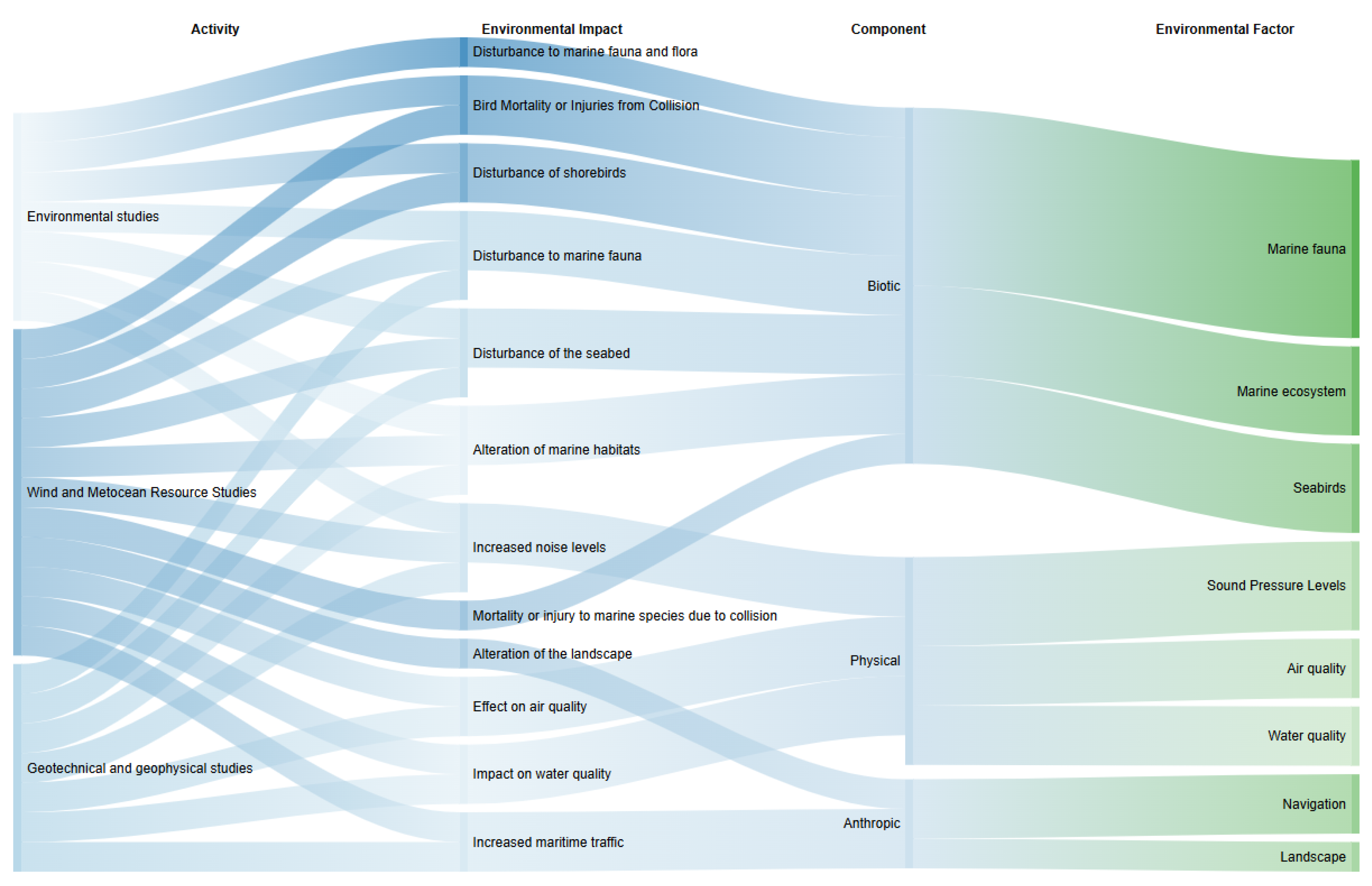
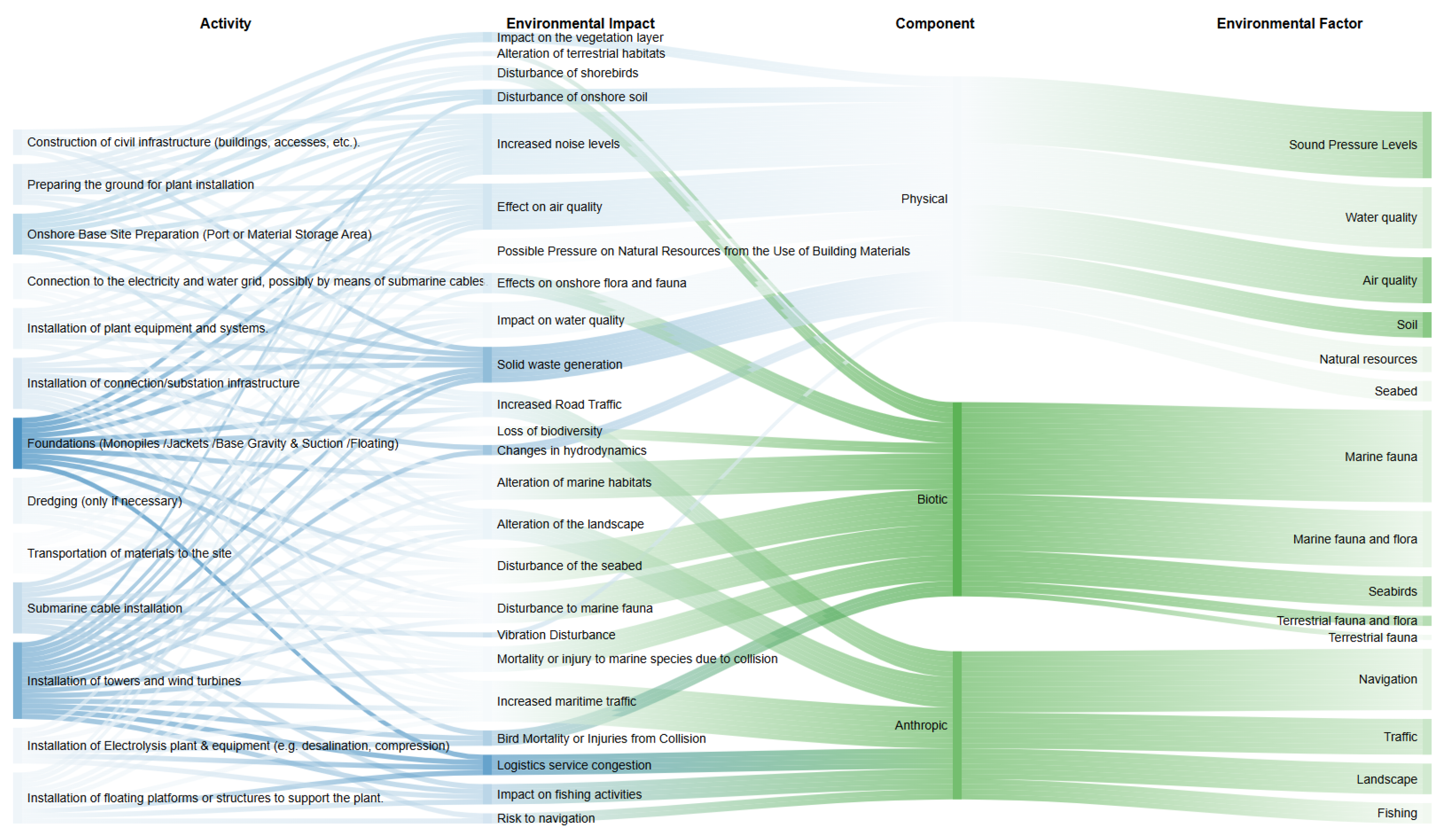
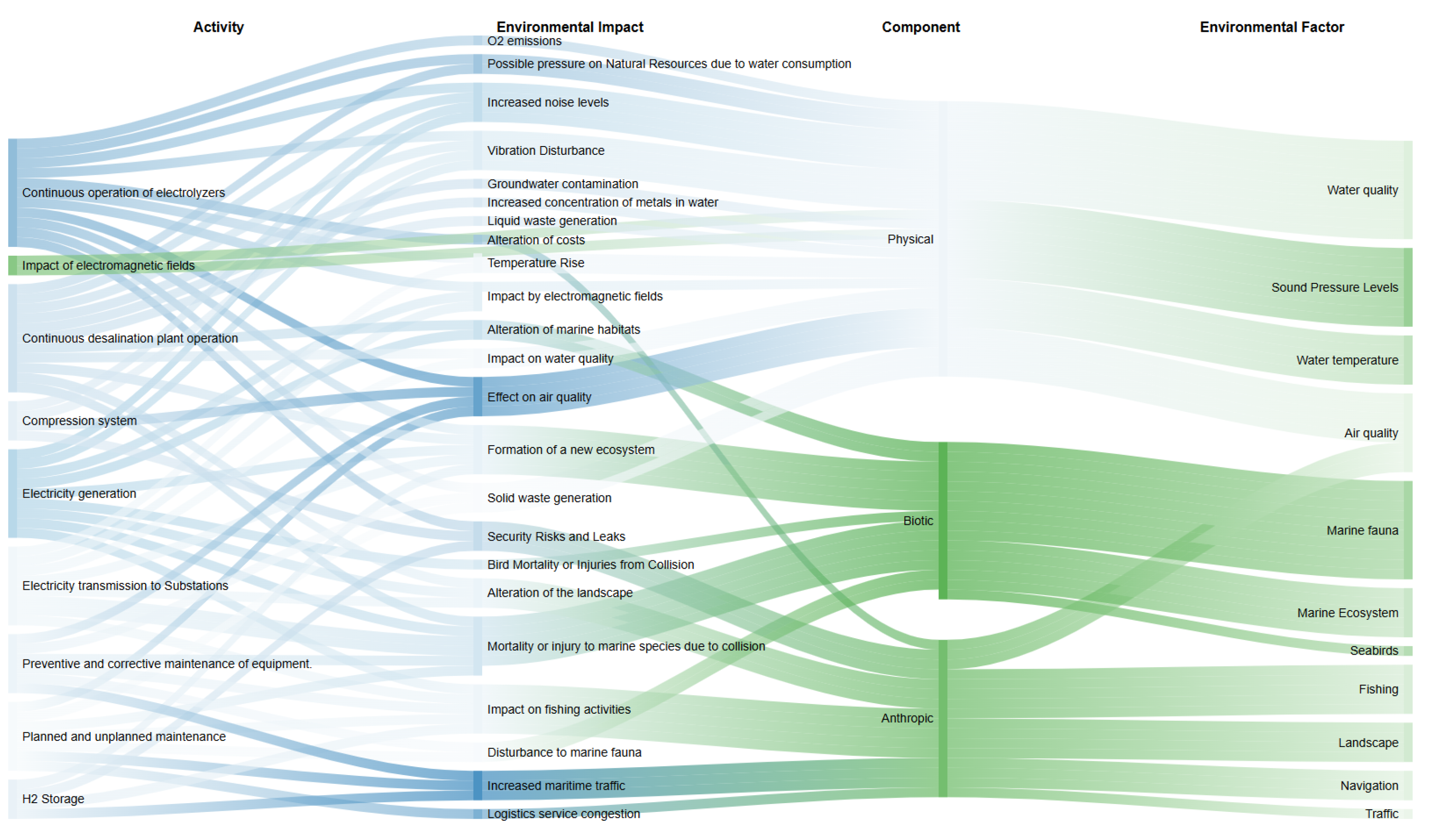
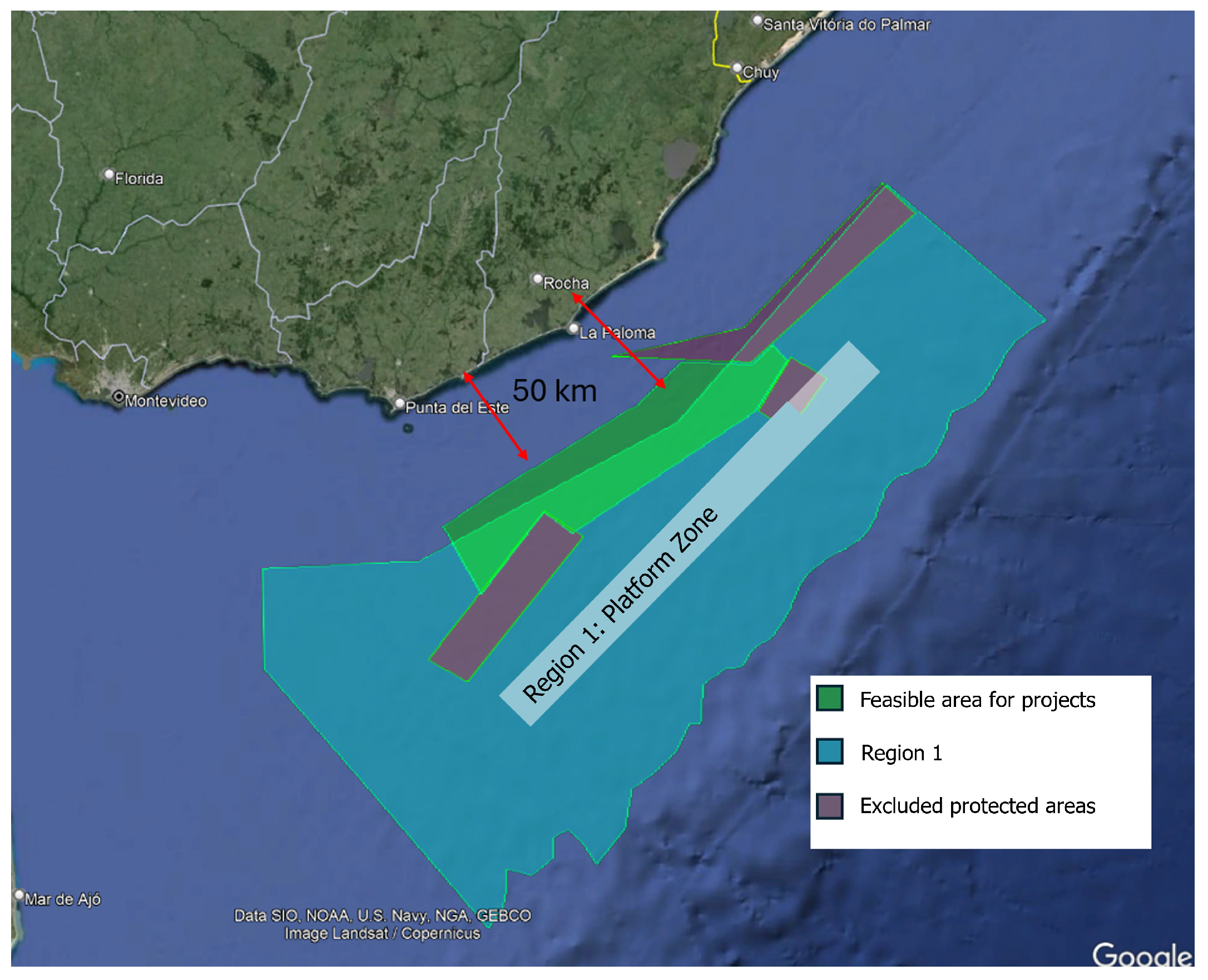
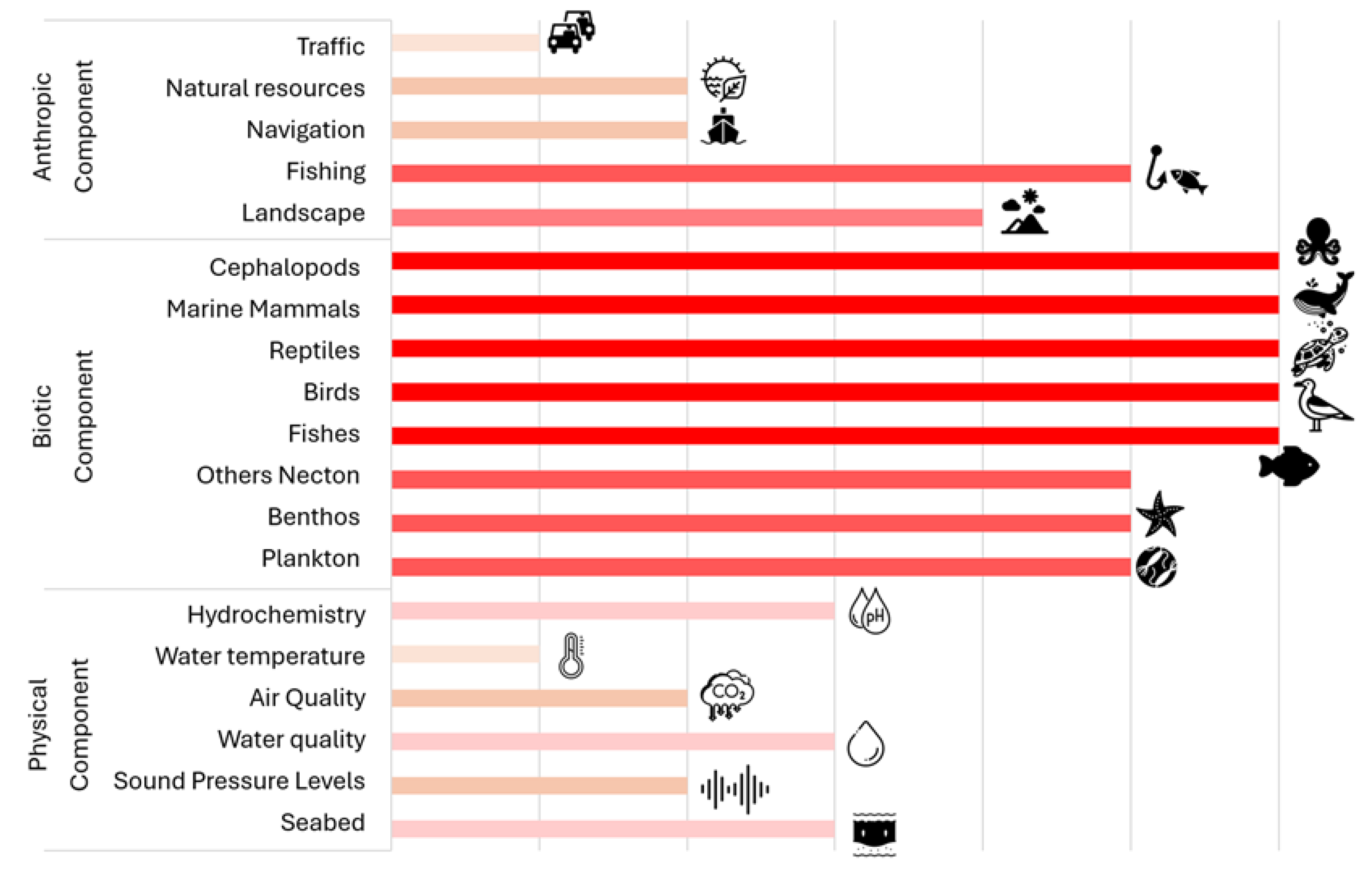
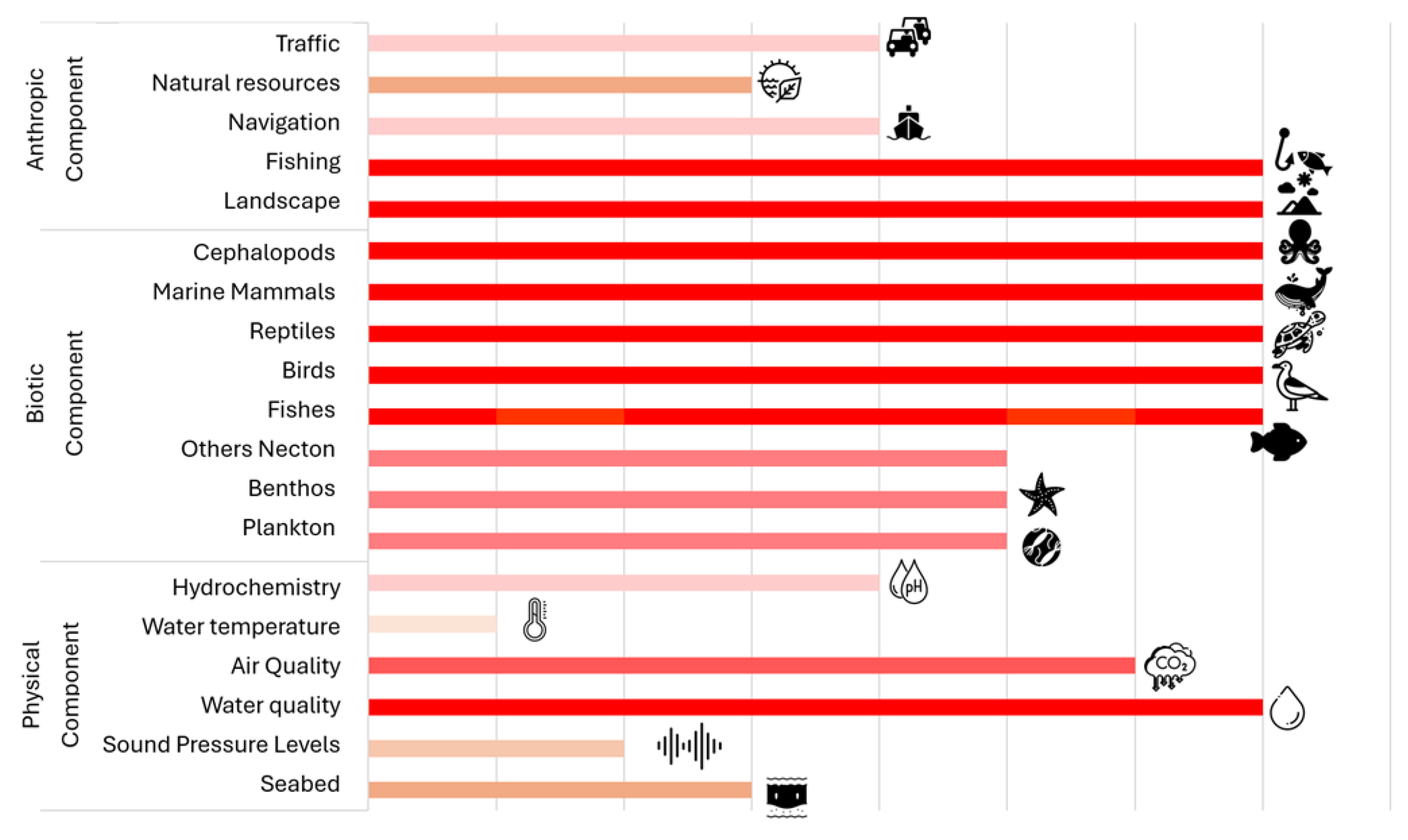
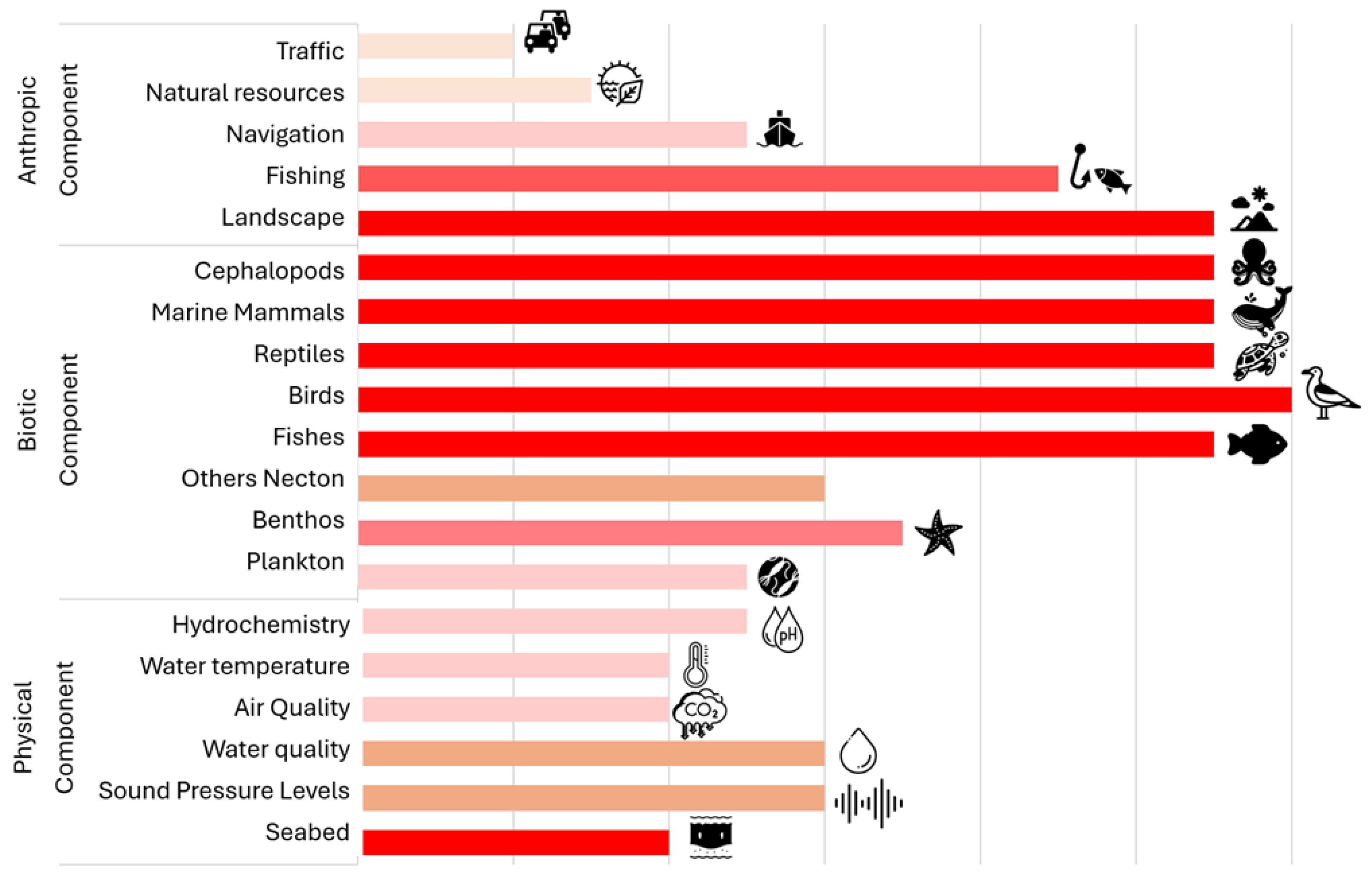
Disclaimer/Publisher’s Note: The statements, opinions and data contained in all publications are solely those of the individual author(s) and contributor(s) and not of MDPI and/or the editor(s). MDPI and/or the editor(s) disclaim responsibility for any injury to people or property resulting from any ideas, methods, instructions or products referred to in the content. |
© 2025 by the authors. Licensee MDPI, Basel, Switzerland. This article is an open access article distributed under the terms and conditions of the Creative Commons Attribution (CC BY) license (https://creativecommons.org/licenses/by/4.0/).
Share and Cite
Rivas, L.; González, A.E.; Gutiérrez, A. Critical Environmental Factors in Offshore Wind–Hydrogen Projects: Uruguay’s Exclusive Economic Zone. Sustainability 2025, 17, 6096. https://doi.org/10.3390/su17136096
Rivas L, González AE, Gutiérrez A. Critical Environmental Factors in Offshore Wind–Hydrogen Projects: Uruguay’s Exclusive Economic Zone. Sustainability. 2025; 17(13):6096. https://doi.org/10.3390/su17136096
Chicago/Turabian StyleRivas, Luisa, Alice Elizabeth González, and Alejandro Gutiérrez. 2025. "Critical Environmental Factors in Offshore Wind–Hydrogen Projects: Uruguay’s Exclusive Economic Zone" Sustainability 17, no. 13: 6096. https://doi.org/10.3390/su17136096
APA StyleRivas, L., González, A. E., & Gutiérrez, A. (2025). Critical Environmental Factors in Offshore Wind–Hydrogen Projects: Uruguay’s Exclusive Economic Zone. Sustainability, 17(13), 6096. https://doi.org/10.3390/su17136096






